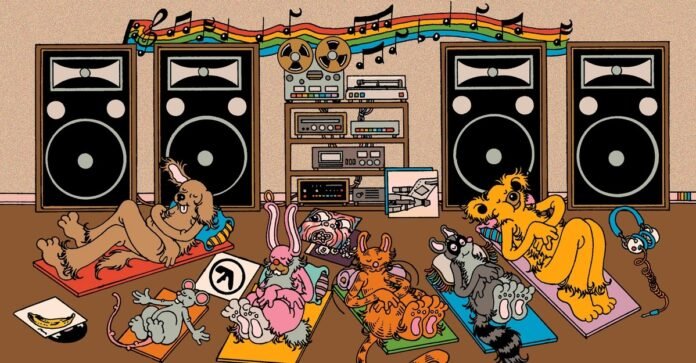The Evolution of Music Listening: From Communal to Individual
In 1986, the Beastie Boys released “(You Gotta) Fight for Your Right (To Party!),” a song that encapsulated the spirit of youthful rebellion. Its appeal was straightforward: it transformed the act of defying authority—be it parents, teachers, or any figure of authority—into a universal anthem. One of the most memorable moments in the song is when the group cranks up their music, a rebellious act that resonated with kids everywhere. This simple act of blasting music became a form of protest that was easy for anyone to replicate.
Fast forward nearly four decades, and the landscape of music listening has dramatically changed. My daughter, now 9, will likely not face the same rebellious music battles I did as a teenager. Instead of demanding she turn down her music, I might find myself asking her what she’s listening to. The culture of music consumption has shifted towards a more insular experience. In 2024, approximately 455 million headphones were sold globally, marking a 59% increase since 2014. A staggering 78% of streaming consumers now prefer headphones or earbuds, creating a world where public spaces are filled with individuals blissfully disconnected from their surroundings. This shift is epitomized by songs like Addison Rae’s “Headphones On,” which celebrates the act of isolating oneself from the outside world.
The Radical Shift of Headphone Listening
Headphone listening is not just a trend; it’s a radical transformation in how we experience music. The visible barrier created by headphones is evident, but the invisible barrier is equally significant. As we immerse ourselves in our own musical echo chambers, we risk losing the shared cultural experiences that music once provided. Music has historically served as a soundtrack for generations, evoking emotions and memories tied to specific times and places. However, headphone listening isolates the individual, diminishing music’s cultural footprint.
In the vinyl era of the 1960s and ’70s, communal listening was a cherished ritual. People gathered for album-release parties, sharing the experience of listening to new music together. My father fondly recalls the excitement of hearing a new Beatles album with friends. As the decades progressed, these communal experiences became less common. The rise of MTV and the diversification of music genres led to a more fragmented listening culture. While I grew up in the ’90s, I still encountered music in shared spaces—whether it was the TVs in my high school’s student center or listening to albums in friends’ dorm rooms.
The Shift from Communal to Private Listening
While I did enjoy private listening sessions with headphones, they were a rarity compared to today’s norms. Back then, corded headphones tethered us to our stereos, limiting our listening experiences. The advent of portable devices like the Walkman and Discman offered some freedom, but they were cumbersome. Carrying a CD wallet was a hassle, especially when compared to the effortless portability of today’s streaming services.
Now, the balance has shifted dramatically. Music is still present in our lives, but it is consumed more privately than communally. This evolution reflects a broader cultural shift from music as a unifying force to music as an individual pursuit. Headphones have transformed music from something that once filled shared spaces into a solitary experience.
Streaming Services and the Fragmentation of Music Culture
The rise of streaming platforms like Spotify has further fueled this trend. These services promise access to an extensive library of music at little to no cost. While this abundance is appealing, the design of these platforms encourages listeners to move quickly from one song to another, prioritizing breadth over depth. The very term “streaming” implies a continuous flow, promoting a culture of fleeting engagement rather than deep connections with artists or albums.
Listeners are nudged toward playlists that encourage hopping between tracks, which can dilute the impact of an artist’s work. I often wonder if I would have discovered albums like the Cure’s Disintegration had I grown up in the headphone era. Would I have listened long enough for it to leave a lasting impression?
The Cultural Consequences of Isolated Listening
As this individualistic listening behavior spreads, the cultural conversation surrounding music quiets. While music is omnipresent, its significance seems to diminish. In the past decade, the number of musical performances on late-night shows has plummeted, with only about 200 performances in 2023. Publications that once focused heavily on music, like NME, have broadened their coverage to adapt to the era of fragmented tastes. The live music scene, now dominated by sprawling festivals with extensive lineups, reflects the haphazard preferences shaped by headphone culture.
Moreover, music faces stiff competition from other forms of entertainment, such as on-demand TV, immersive gaming, and social media. General-interest publications, like Entertainment Weekly, have shifted their focus away from music, highlighting the growing divide between music and other entertainment forms.
Signs of a Countercurrent
Despite these trends, there are signs of a countercurrent. Some newer listening options hint at a desire for more cohesive experiences. Music-themed cruises, catering to specific genres, offer fans a chance to share curated musical experiences in a communal setting. Additionally, music influencers are experimenting with live-listening sessions on platforms like Twitch, attempting to recreate the communal listening experiences of the past in a digital format. These initiatives suggest a yearning for deeper, more connected musical experiences.
Recently, my wife and I tried to bridge this divide by buying our daughter a small stereo. Weeks later, I realized I hadn’t heard any music from her room. When I asked her why, she sheepishly admitted, “Daddy, I didn’t want you to hear anyone say a bad word.” This unexpected response serves as a reminder that music has always existed in the tension between the private and the public, between the songs we cherish and the ones we share without hesitation. It’s a delicate balance, and I hope she learns to appreciate the value of both experiences.

